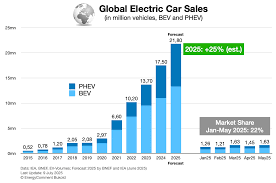The Automobile Industry and the Rise of Electric Vehicles (EVs): A Look at Market Share
Introduction
The automobile industry is going through one of the biggest changes in its history. For more than a hundred years, cars have mostly used petrol or diesel engines. But now, a quiet revolution is taking place — the rise of Electric Vehicles (EVs).
Electric vehicles run on batteries instead of fuel. They are cleaner, quieter, and cheaper to maintain. Governments, car companies, and even everyday people are turning toward electric options.
In this article, we’ll explore how EVs are changing the automobile industry, how much market share they now hold, what’s driving this shift, and what challenges still remain.
What Are Electric Vehicles (EVs)?
Electric Vehicles, or EVs, are cars that use electric power instead of gasoline or diesel. They have one or more electric motors powered by rechargeable batteries.
There are mainly three types of EVs:
-
Battery Electric Vehicles (BEVs) – These are fully electric and do not use fuel at all. (Example: Tesla Model 3, Nissan Leaf)
-
Plug-in Hybrid Electric Vehicles (PHEVs) – These can run on both battery and fuel. (Example: Toyota Prius Plug-in)
-
Hybrid Electric Vehicles (HEVs) – These charge their batteries from the engine itself and do not plug in. (Example: Toyota Camry Hybrid)
Among these, Battery Electric Vehicles (BEVs) are growing the fastest because of lower running costs and zero emissions.
The Current Market Share of Electric Vehicles
Global Overview
In the past few years, the global EV market has grown at an incredible pace. According to 2025 data estimates:
-
EVs now make up around 20–25% of total new car sales worldwide.
-
In some regions like Europe and China, the share is even higher — close to 35%.
-
The United States has also crossed 15% of new car sales being electric.
Just five years ago, EVs held less than 5% of the global car market. This shows how fast adoption is increasing.
Regional Highlights
-
China: The world leader in EVs, accounting for more than 50% of global sales. Chinese brands like BYD and NIO are growing quickly.
-
Europe: Countries like Norway, Germany, and the Netherlands are pushing for full EV adoption by 2035.
-
United States: Tesla remains the top EV brand, but Ford, Chevrolet, and Rivian are catching up.
-
India: EVs still have a smaller share (around 2–3%) but are growing fast due to government incentives.
Why EVs Are Gaining Popularity
1. Environmental Benefits
Traditional cars burn fossil fuels, releasing harmful gases like carbon dioxide. EVs produce zero tailpipe emissions, making them better for air quality and the planet. This helps fight global warming and reduces pollution in cities.
2. Lower Running Costs
Electric vehicles are cheaper to run than petrol or diesel cars. Charging a battery costs much less than refueling with gasoline. Also, EVs have fewer moving parts, so they need less maintenance — no oil changes, fewer repairs, and longer lifespan for brakes.
3. Government Support
Many countries offer tax cuts, rebates, and subsidies to encourage EV purchases. Some cities also provide free parking, lower tolls, or allow EVs to use special lanes.
4. Technological Improvements
Battery technology has improved a lot. Modern EVs can now travel 400–600 km per charge, and fast chargers can recharge them in less than 30 minutes.
5. Rising Fuel Prices
As fuel prices keep rising, more people are switching to EVs for long-term savings.
Major EV Companies in the Market
1. Tesla (USA)
Tesla remains the global leader in EV sales. Its popular models like the Model 3, Model Y, and Cybertruck dominate the market. Tesla’s supercharger network and innovative design give it a strong edge.
2. BYD (China)
BYD has become the world’s largest EV manufacturer by volume. It produces both electric cars and buses and competes directly with Tesla in Asia.
3. Volkswagen (Germany)
Volkswagen is making a big move toward electric cars with its “ID” series — such as ID.4 and ID.7. It plans to go fully electric in Europe by 2035.
4. Hyundai & Kia (South Korea)
Hyundai’s IONIQ 5 and Kia’s EV6 are popular globally. They’re known for advanced design and long range.
5. Tata Motors (India)
In India, Tata Motors leads the EV race with affordable options like Nexon EV and Tiago EV.
EV Market Share by Vehicle Type
Electric vehicles are not only cars. The market includes bikes, scooters, buses, and trucks too.
-
Two-wheelers: In Asia, especially India and China, electric scooters and bikes hold a big share — over 40% in some cities.
-
Buses: Many countries are replacing diesel buses with electric ones for public transport.
-
Trucks: Companies like Tesla, Volvo, and Rivian are testing electric trucks for long-distance transport.
Challenges Facing the EV Market
Despite strong growth, electric vehicles still face a few big challenges:
1. High Purchase Price
EVs are often more expensive than fuel cars. Though costs are falling, batteries still make up about 30–40% of the vehicle’s price.
2. Charging Infrastructure
Not every area has enough charging stations. People worry about where to charge during long trips. Expanding charging networks is a key focus for governments.
3. Battery Disposal & Recycling
Old batteries contain chemicals that must be recycled safely. The EV industry is working on better recycling systems to reduce waste.
4. Limited Range for Some Models
While top EVs can travel 500+ km, cheaper models often have shorter ranges, which can discourage buyers.
5. Consumer Awareness
Many people still don’t fully understand EV benefits or worry about repair and maintenance. Education and awareness are improving slowly.
The Future of the EV Market
Experts believe the next five to ten years will completely transform the automobile industry.
-
By 2030, EVs could make up 50% or more of all new car sales globally.
-
Battery costs are expected to drop by nearly half, making EVs as cheap as fuel cars.
-
Fast charging stations will become as common as petrol pumps.
-
More EV startups will appear, giving buyers many new choices.
In the long term, EVs are not just replacing fuel cars — they are changing how we think about travel, energy, and sustainability.
How EV Growth Affects the Automobile Industry
1. Traditional Car Makers Are Adapting
Companies like Toyota, Ford, and General Motors are now investing billions in EV technology. They know that if they don’t adapt, they’ll lose their customers to new players like Tesla and BYD.
2. Job Market Changes
EV manufacturing requires different skills — more electronics and less mechanical work. So, new jobs are appearing in battery production, software, and robotics.
3. Supply Chain Transformation
EVs depend on raw materials like lithium, cobalt, and nickel. This has created new global supply chains and new challenges around mining and sustainability.
4. Charging and Energy Demand
As millions of EVs plug in, electricity demand is rising. Governments are upgrading power grids and promoting renewable energy sources to handle the load.
Why EV Market Share Will Keep Growing
Here’s why EV adoption is likely to keep increasing:
-
Falling battery prices make EVs more affordable.
-
Global climate policies favor clean energy.
-
Automakers are investing more in EV production.
-
Charging networks are expanding rapidly.
-
Consumers want quiet, modern, low-maintenance cars.
In short, the EV revolution is unstoppable — it’s only a matter of how fast it happens.
Conclusion
The automobile industry is standing at a major turning point. Electric vehicles have moved from being a luxury choice to a common, practical option. With cleaner technology, lower running costs, and strong government support, EVs are quickly taking over market share across the world.
Challenges like high prices, charging infrastructure, and battery recycling remain — but progress is being made every year.
The message is clear: The future of the automobile industry is electric.
Countries, companies, and consumers are all driving toward the same goal — a cleaner, smarter, and more sustainable way to move.
So, the next time you see an electric car pass silently by, remember — you’re not just watching a car. You’re watching the future of transportation in motion.

